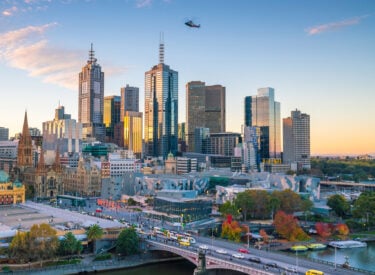Australia’s rental market is in crisis.
Vacancy rates remain extremely low, rental stock is extremely slim, and high rental prices mean the market is red-hot. .
So how did we get into this rental crisis?
How long will it last?
And what does it mean for property investors?
Currently, Australian residential rental markets still heavily favour landlords, as tenants face challenging conditions due to increasing demand and a limited supply of rental properties.

Note: The latest Domain report reveals that Australia’s era of explosive rental growth appears to be nearing its end.
But despite the evident slowdown in rental growth, tenants are still grappling with record-high asking rents across most of the country.
Across the combined capitals, data shows that house rents increased 8.3% year-on-year and remained unchanged over the three months to September.
Meanwhile, median unit rent across the combined capitals has maintained a record $630 per week, unchanged over the quarter but up % year-on-year.
Domain notes that rental demand is easing, with the number of prospective tenants per rental listing on Domain falling to its lowest level since 2019, indicating a better balance between supply and demand.
At the same time, affordability constraints are driving demographic shifts, prompting tenants to seek house shares or opt for intergenerational living to alleviate the financial strain.
On the supply side, one encouraging shifts has been a rise in investment activity, with the value of investor loans rising by 35% annually.
It seems strategic investors are looking to get ahead of the crowd before the RBA lowers their cash rate which will likely spark housing activity, but while the trend is promising, fact is, there is a very long way to go before the crisis winds down.
Why is there a rental crisis in Australia?
The main reason is simple: Australia’s rental market is undersupplied.
A balanced rental market has a vacancy rate of around 2%, and anything below 2% describes a situation where tenant demand exceeds the supply of available properties.

Note: The current national vacancy rate sits at just 1.2%.
Why so low?
Put simply, there are fewer rental properties in Australia today because there are fewer investors buying property (owner-occupiers have dominated the market) and the number of investors selling up has trended upwards.
There are nearly 11 million households in Australia and the majority are owner-occupiers.
In fact, 67% of those households are homeowners, while 31% (which equates to around 7 million people) are renters.
The remaining 2.1% (192,200 households) are other tenures, including households that are not an owner with or without a mortgage, or a renter.
The problem is, there just isn’t enough rental stock available for 31% of the population.
Why?
There are several reasons…
1. Supply is low
A large number of investors have been selling up. According to data by PropTrack, approximately 30% of sellers in the market currently are/were investors, and similarly, many investors (mistakenly) sold up during the post-COVID-19 property boom of 2020-21 as they looked to secure peak prices for their properties and sell up. Many of these properties were purchased by owner-occupiers, effectively reducing the supply of rental/investment properties.
- High borrowing costs mean fewer investment properties are currently being bought. The increasing cost of property and high interest rates have also dampened the number of people buying and renting out investment properties.
- Not only has the number of properties available for purchase dropped significantly, but the cost of buying and servicing the mortgage has also risen sharply.
This is also evident in the lower number of investment loans in Australia over the last few years.
For the 6 years between 2017 and 2022, 31% of all new loans were made for investment purposes compared to 38% for the previous 14-year period between 2002 and 2016 - that’s far below average.
The number of Australian Property Investors:
| Year | Total | Δ YoY |
|---|---|---|
| 2009-10 | 1,704,220 | 68,316 |
| 2010-11 | 1,765,880 | 61,660 |
| 2011-12 | 1,854,519 | 88,639 |
| 2012-13 | 1,942,339 | 87,820 |
| 2013-14 | 2,010,923 | 68,584 |
| 2014-15 | 2,051,517 | 40,594 |
| 2015-16 | 2,097,382 | 45,865 |
| 2016-17 | 2,156,319 | 58,935 |
| 2017-18 | 2,207,893 | 51,574 |
| 2018-19 | 2,227,174 | 19,281 |
| 2019-20 | 2,226,841 | -333 |
| 2020-21 | 2,245,539 | 18,698 |
Source: ABS
3. Increased government intervention dissuades investors
Tighter rental laws certainly dissuade people from investing in property, and over the last few years, many of our state governments have been changing tenancy legislation in favour of tenants.
One of the most attractive advantages of property investing is control—you want to have full control over how you use and improve your assets.
These new tighter rental laws (that favour tenants) reduce the amount of control investors have over their property (like the 130 changes Victoria rolled out in 2021).
They also increase the cost to run a rental property thereby reducing investment returns.
Note: Whilst tighter rental laws have reduced investor demand (and therefore the number of rental properties available), any further regulation would most likely have an even further material impact on rental supply.
Sure, tenants must be protected but a healthy rental market is equally, if not more, important.
4. Supply of new builds is also thin
During the pandemic, soaring materials and construction costs meant that fewer new dwellings were completed.
Significant government support for the construction industry, such as HomeBuilder, had a large effect on the increased number of houses that were constructed (and are still under construction).
But this was offset by reduced unit construction.
Unit construction has much longer construction times, and uncertainty about demand and the economic environment delayed many projects.
At the same time, this combination of headwinds means there has been an uptick in the number of building companies going into insolvency.
Overall, the supply of new-build properties is much lower than prior to the pandemic.

Note: Not only is supply tighter, but demand for rental properties is also trending upwards, putting further pressure on the rental market.
5. Migration levels are higher
An increase in regional migration during the pandemic led to increased rent values and low vacancy rates in regional Australia and major cities.
Since the international border reopened in early 2022, there has also been an influx of migrants coming into the country… looking for rental properties to live in.
The PropTrack Overseas Search Report in August 2024 revealed that searches from abroad had continued to increase since its last report, largely due to elevated interest from the United States.
Buy searches rose by 9% month-on-month and 3% year-on-year and and rent searches rose by 8% month-on-month but were down 1% year-on-year.
Both buy and rent searches are now well above pre-pandemic levels and are set to continue rising now that migration has returned to previous levels.
That’s a huge volume of additional people looking for somewhere to live.
6. Smaller households have increased the number of properties we need
A seemingly tiny shift in the composition of the average household has also added to our housing crunch.
Over recent decades, the number of single-people households and single-parent households has increased and as a result, the average household size has decreased.

Census data shows that the share of households with just one person in them increased significantly from 2016 to mid-2021. At the same time. there were fewer households with three or more people.
Over the last few years, the average household size has fallen from 2.59 to 2.55 people. While this doesn’t sound like a large fall, it translates to the need for around 160,000 additional dwellings just to house the same number of people.
Also, people needed more space for home offices and wanted larger dwellings with more outdoor space because of lockdowns and remote work.
So when will rental prices go down?
There is a bottleneck of Australians trying to buy their first home with the increased cost of housing has made it more difficult for many young people to afford to buy a home and the changing preference of younger generations to lay their roots down later in life means the rent for longer rather than buy a home.
Government data shows that certain age groups exhibit more significant declines in homeownership rates over time.
For example, between 1971 and 2016, the number of homeowners aged 25-34 years dropped to 44.6%, from 57.0%, and in the 35–44 year age range, rates fell to 62.2%, from 71.4% - today those figures are much lower at 40.7% and 56.7% respectively.
These age groups have also suffered a steep decline in income and are severely affected by the cost of living crisis.
The combination, therefore, has created a bottleneck of renters unable to get onto the property ladder and become owners.

Note: No, there is no end in sight for Australia’s rental crisis.
It’s bad news I’m afraid.
Australia’s housing crisis isn’t going to be resolved any time soon…
Here’s why...
Australian rental market predictions
A perfect storm of ultra-low vacancy rates, rising rents, rising rental and low supply is strong.
Given the stark imbalance between supply and demand, it is unlikely there will be much real relief for renters over the short- to medium-term, with stock levels, especially for apartments, unlikely to increase substantially anytime soon.
Net migration is forecast to remain strong for some time yet, which will only add further upward pressure on rental values.
Tenants coming up against affordability constraints have limited opportunities and unlike homeowners can’t borrow to pay rent.
It’s likely some tenants are now sacrificing the spare room or home office and re-forming the shared houses they disbanded throughout COVID in order to share the rental burden.
Those who have the financial means to pull together a deposit might be taking the plunge into homeownership sooner while others are locking in longer leases, rather than brave the hunt for a new rental.
Net migration is going to increase further
Australia is having difficulty creating enough accessible, reasonably affordable houses and units to shelter our current population.
Yet thrown into this mix, is also a whole new wave of demand in the form of immigration.
After years of closed borders, we flung Australia open to the world in early 2022, welcoming back overseas arrivals helps deliver on a few fronts – particularly in terms of filling job vacancies, but also in helping strengthen the economy.
But that flood of new migrants comes at a cost.
Australia’s population recently reached 27 million, and has increased by 615,300 over the past 12 months, equivalent to adding more than the population of the entire state of Tasmania (572,800) in just one year.
And based on the latest annual growth rate of 2.3%, Australia’s population will be 41 million by 2042, 16 million more than the 2002 forecasts.
The question is: Where are all these people going to live?

Tip: Remember, most new residents rent for the three to five years before they finally settle into a home of their own.
Government intervention is only making matters worse
Add to this the fact that current policies are not supportive of attracting more private property investors to supply rental accommodation and the future for tenants only looks worse.
Just look at some of the hurdles property investors have had to put up with over the last decade:
- 2014 - APRA’s macroprudential controls throttled the banks’ ability to lend to investors.
- 2016 - APRA Limited interest-only lending.
- 2017 - The federal Labor Party is threatened to remove negative gearing which lasted them an election when they tried again in 2019.
- 2017 - Removing depreciation claims on existing properties and travel bans to inspect your investments.
- 2019 - APRA increased buffers and the lending “floor rate” to 7%.
- 2020 - Victorian government's massive tenancy law reforms favouring tenants.
- 2021 - APRA lift lending buffers to 3%.
- 2021 - QLD government’s Tenancy Reforms announced.
- 2022 - The RBA starts raising interest rates.
- 2023 - ACT and WA propose tenancy reforms.
- 2024 - New rental reforms in QLD, SA, WA, QLD came into effect and NSW and VIC proposed changes.
Boy, property investors have had a lot to put up with!
Sure, the government is now looking for large corporations to enter the ‘build to rent’ sector, but this will take time, only occur in certain locations, and won’t provide “affordable accommodation.”
And the government’s policies to encourage considerably more construction are now well recognised and unrealistic and unachievable
Then there is the Green Party’s proposed rental freeze or cap.
Researchers cited by the Greens to push for a rent freeze concluded that cities experimenting with the controversial controls experienced no improvement in affordability.
In actual fact, it just created poorer quality housing as landlords slowed spending on upkeep.
So capping rental income for investors has been proven to translate directly to poorer quality housing stock.
And less of it.
Not only will many landlords be forced to spend less on the upkeep of their rental property in order to keep up with rising ownership costs, but many will divest the market altogether.
Yes, it could actually make the level of rental stock trend further downward.

Note: Unfortunately, there is no easy fix to this housing crisis.
The key issue is a supply problem, and the only way to increase the supply of rental properties is to encourage more private investors into the market.
There are a few things that governments can do to achieve that:
- Make sure rental laws are balanced by providing enough protection for renters whilst still giving landlords enough control over their valuable assets.
- Encourage more Australian mums and dads to invest in property and stop putting barriers in the way.
- Make it a little easier for investors to borrow
At present lenders “stress test” a borrower’s ability to service a loan at 3% higher than current interest rates, which means interest-only investment loans are being tested at a rate of over 9% p.a., principal and interest, over 25 years e.g., loan repayments on a $1m investment loan would be $94k p.a. – almost double actual repayments ($56k p.a.).
The benchmark interest rate must be reduced because a 3% buffer is no longer necessary if we are at the top of the interest rate cycle.
A window of opportunity for investors
I see a window of opportunity for property investors with a long-term focus right now.
This window of opportunity is not because properties are cheap, but when you look back in 3 years' time the price you would pay for the property today will definitely look ‘cheap’.
The opportunity arises because consumer confidence is low at present, with many prospective homebuyers and investors sitting on the sidelines.

Sooner rather than later many prospective buyers will realise that interest rates are near their peak and that inflation has peaked as the RBA's efforts have brought it under control.
And at that time pent-up demand will be released as greed (FOMO) overtakes fear (FOBE - Fear of buying early), as it always does as the property cycle moves on.
We saw an opportunity like this in late 2018-early 2019 when fear of the upcoming Federal election stopped buyers from entering the market.
And look at what's happened to property prices since then.
I saw similar opportunities at the end of the Global Financial Crisis and in 2002 after the tech wreck.
History has a way of repeating itself.
Strategic investors will take advantage of the opportunities our property markets will offer over the next couple of years maximising their upsides while protecting their downsides.
Now I'm not suggesting taking advantage of tenants, what I'm suggesting is to recognise there is currently a problem (lack of rental accommodation) and provide a solution.

Note: While the current property market might not be attractive for investors right now due to high costs, government interventions, and a low supply of property for sale, it’s important to remember that property investment is a long-term game.
Don’t try to time the market - this is just too difficult.
And don’t hunt down a bargain.
All investors should focus all their efforts on buying an investment-grade property in an A-grade location.
These types of properties are in short supply but are still selling for reasonably good prices.
Plus they’ll hold their value far better in the long term.
While it might feel counterintuitive to buy in a correcting market, you can also benefit from less competition, low consumer sentiment, having more time, and minimal risk of oversupply.

Tip: Remember, the rental crisis is only worsening further, with no end in sight.
Now would be a great time to buy an investment property and enjoy high demand while trying to be a part of the rental crisis solution.
Maybe others might follow in your footsteps.














